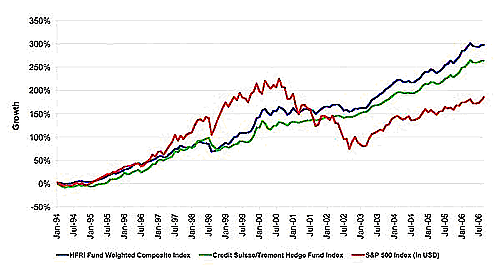Hedge Funds Hunt For Upside Regardless Of The Market_1
Post on: 22 Май, 2015 No Comment

Challenge 2: Low Interest Rates
Higher interest rates increase a business’s cost of capital, leading to increased differentiation in the performance of companies with different capital structures. With higher rates come higher interest expenses, and a company with relatively thin operating margins and too much leverage may find its debt burdens providing significant headwinds in such an environment. On the other hand, a company with less debt and higher operating margins will likely fare better in such an environment. Historically, there has been a positive correlation between intermedi-ate-term interest rates (a key component of corporate capital costs) and the amount of valuation dispersion (based on companies’ price-to-earnings multiples) in the market. There has also been a positive correlation between valuation dispersion in the market and hedge fund Jensen’s alpha (see Figure 2).
Once interest rates begin to rise and approach historical norms, we believe that valuation dispersion should also increase, leading to an envi-ronment in which fundamental stock pickers with more effective security selection can be better rewarded.
Another challenge of near-zero interest rates has been their impact on the short rebate, the interest a fund receives on cash proceeds from its short sales, less the various transaction costs and borrowing fees associated with the mechanics of shorting. Typically these proceeds are held in an interest-bearing money market account. In the current environment of near-zero interest rates, the short rebate does not amount to much (and may in fact be negative, as transaction costs may outweigh the interest), but in a more normalized (e.g. pre-crisis) interest rate environment, the short rebate has added as much as 150 – 200 basis points of performance for managers with substantial short exposure.
Importance of manager selection
In our view, manager skill is critical in a successful long/short investment program. Alpha can be either positive or negative, and the fewer constraints on investing, the larger is its potential magnitude (on the upside or downside). In fact, dispersion among individual manager returns is substantial in Hedge Funds .

As an example, Figure 3 shows the dispersion of 1-, 3-, 5-, and 10-year returns for a peer group universe of US equity-focused long/short managers versus the eVestment peer group universe of US equity-focused long-only managers. The variation is substantial, and meaningfully larger for the long/short peer group than is the case of long-only managers.
Return and risk profiles also differ by funds’ gross exposure levels and shorting strategies. Holding net exposure constant, a fund with larger gross exposure is running a more active portfolio than a fund with smaller gross exposure. Therefore, the former fund would have more capacity to generate alpha (positive or negative) and can also have higher drawdowns and/or volatility. Similarly, funds that engage in fundamental shorting of individual securities have the potential for extra alpha generation (again, positive or negative) relative to funds that engage only in overall market shorting that acts solely as a beta hedge to its long positions.
See full PDF below.
Like this article? Sign up for our free newsletter to get articles delivered to your inbox














